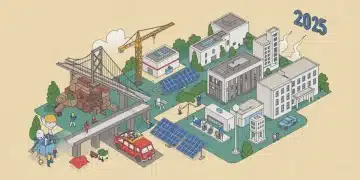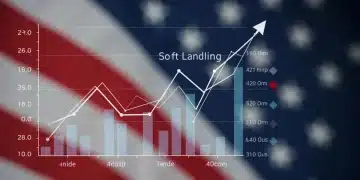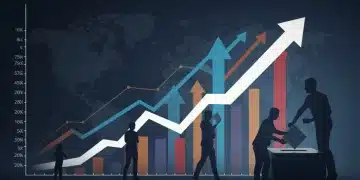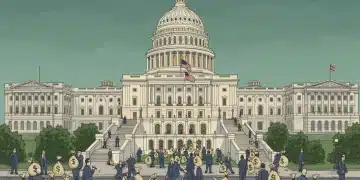National Debt in 2025: Shaping Fiscal Policy Debates

The increasing United States national debt is expected to significantly shape the debate on fiscal policy in 2025 by forcing difficult choices on government spending, taxation, and long-term economic sustainability.
As the calendar turns to 2025, the question of how is the increasing national debt expected to shape the debate on fiscal policy in 2025 looms large over Washington D.C. and indeed, the entire nation. The escalating debt, a complex issue years in the making, is set to become an undeniable force, compelling policymakers to confront difficult decisions that will influence every aspect of American life, from social programs to defense spending and economic growth.
Understanding the Current Trajectory of National Debt
The United States national debt has been on an upward trajectory for decades, punctuated by significant spikes during economic crises and periods of increased government spending. In 2025, this trend is projected to continue, driven by a combination of factors that include demographic shifts, rising healthcare costs, and interest payments on existing debt. Understanding the underlying causes and the sheer scale of this accumulation is crucial for grasping the gravity of the impending fiscal debates.
Several key elements contribute to this persistent rise. Mandatory spending, primarily on Social Security and Medicare, accounts for a substantial portion of the federal budget and is expected to grow as the population ages. Discretionary spending, while more flexible, also plays a role, especially in areas like defense and infrastructure. Furthermore, tax revenues, while significant, often do not keep pace with expenditures, leading to perennial budget deficits that add to the national debt.
Key Drivers of Debt Accumulation
- Aging Population: Increased demand for Social Security and Medicare benefits.
- Healthcare Costs: Continuously rising expenditures in the healthcare sector.
- Interest Payments: Growing cost of servicing the existing national debt, especially with fluctuating interest rates.
- Tax Policy: Revenue collection not keeping pace with spending.
The sheer volume of the national debt means that even small changes in economic conditions, such as interest rate hikes, can have a profound impact on the federal budget. This adds an element of unpredictability and urgency to the fiscal policy discussions that will undoubtedly intensify in the coming year. Policymakers will be forced to scrutinize every line item, balancing immediate needs with long-term fiscal responsibility.
In conclusion, the current trajectory of national debt is a complex interplay of demographic, economic, and policy factors. Its continued growth sets the stage for a period of intense scrutiny and difficult choices regarding fiscal policy in 2025, demanding comprehensive and sustainable solutions from lawmakers.
Economic Implications of a Soaring National Debt
The economic implications of a soaring national debt are far-reaching and multifaceted, affecting everything from interest rates and inflation to economic growth and international confidence. As the debt continues to climb, economists and policymakers are increasingly concerned about its potential to stifle future prosperity and create instability. These concerns will undoubtedly be central to the fiscal policy debate in 2025, influencing how lawmakers approach budgeting and economic planning.
One of the most immediate concerns is the impact on interest rates. As the government borrows more to finance its debt, it competes with private borrowers for available capital, potentially driving up interest rates for businesses and consumers. Higher interest rates can slow economic growth by making it more expensive for companies to invest and for individuals to purchase homes or cars. This creates a delicate balancing act for the Federal Reserve and Congress.

Another critical implication is the potential for increased inflation. While not a direct consequence, persistent deficits financed by monetary expansion could lead to an oversupply of money, eroding purchasing power. Furthermore, a high debt load can make a country more vulnerable to external economic shocks, as foreign investors may demand higher returns for holding government bonds, increasing borrowing costs even further.
Potential Economic Consequences
- Higher Interest Rates: Increased borrowing costs for government, businesses, and consumers.
- Reduced Investment: Crowding out private investment due to government borrowing.
- Inflationary Pressures: Potential for currency devaluation and rising prices if debt is monetized.
- Fiscal Space Contraction: Less flexibility for government to respond to future crises.
The long-term effects also include a potential reduction in future economic growth. As a larger portion of the federal budget is allocated to servicing debt, less is available for investments in education, infrastructure, and research and development—areas crucial for long-term productivity and innovation. This intergenerational transfer of debt places a burden on future taxpayers, who will bear the cost of today’s spending.
In summary, the economic implications of a soaring national debt are profound and will necessitate careful consideration in 2025’s fiscal policy discussions. Addressing these challenges will require a comprehensive strategy that aims to mitigate risks and foster sustainable economic growth.
Political Divides and Fiscal Policy Responses
The increasing national debt is not merely an economic problem; it is also a deeply political one, exacerbating existing ideological divides and complicating efforts to forge bipartisan solutions. As 2025 approaches, the debate on fiscal policy will undoubtedly be shaped by these political tensions, with different parties and factions advocating for vastly different approaches to debt reduction and economic management. This makes finding common ground incredibly challenging but also more urgent than ever.
One primary divide centers on the role of government spending. Progressive voices often argue for continued or increased investment in social programs, infrastructure, and climate initiatives, viewing these as essential for societal well-being and long-term economic competitiveness. They may advocate for higher taxes on corporations and high-income individuals to fund these expenditures and address the debt.
Conversely, conservative factions typically prioritize spending cuts, emphasizing fiscal austerity and a smaller government footprint. They often call for reducing entitlement programs, streamlining government agencies, and avoiding tax increases, arguing that such measures stimulate private sector growth and ultimately lead to a more balanced budget. These fundamental disagreements create a chasm in how to tackle the debt.
Contrasting Approaches to Fiscal Policy
- Progressive Stance: Prioritize social spending, infrastructure, climate investment; advocate for higher taxes on wealthy.
- Conservative Stance: Focus on spending cuts, reduced government size, tax cuts; oppose entitlement reform.
- Moderate Approaches: Seek bipartisan compromise, often involving a mix of targeted spending cuts and revenue enhancements.
The political landscape in 2025, potentially following a presidential election, will heavily influence which of these perspectives gains traction. A divided government could lead to gridlock, making significant fiscal reforms difficult. Conversely, a unified government might have the political capital to push through more aggressive measures, though these would still face considerable public and political resistance.
In conclusion, political divides will play a central role in shaping fiscal policy responses to the national debt in 2025. Bridging these ideological gaps will be vital for developing effective and sustainable strategies that address the nation’s financial challenges without further polarizing the political discourse.
Potential Solutions and Their Feasibility
Addressing the increasing national debt requires a combination of robust and politically feasible solutions. As the debate over fiscal policy intensifies in 2025, policymakers will consider a range of options, each with its own set of economic impacts and political challenges. The feasibility of these solutions will depend heavily on political will, public acceptance, and the economic conditions of the time.
One broad category of solutions involves revenue enhancement. This could include raising existing taxes, such as income or corporate taxes, or introducing new taxes, like a value-added tax (VAT) or carbon tax. While these measures could significantly increase government revenue, they often face strong political opposition due to concerns about their impact on economic growth, investment, and household budgets. The equity of such tax changes also becomes a major point of contention.
Another major avenue is spending reform. This involves identifying areas where government expenditures can be reduced or made more efficient. Entitlement programs like Social Security and Medicare are frequently targeted for reform due to their significant and growing costs. However, changes to these programs are politically sensitive, as they affect millions of Americans and are often seen as guaranteed benefits. Discretionary spending, while a smaller portion of the budget, also faces scrutiny.
Key Solution Categories
- Revenue Enhancement: Increasing taxes (income, corporate, consumption) or introducing new revenue streams.
- Spending Reforms: Reducing expenditures in mandatory programs (e.g., Social Security, Medicare) and discretionary spending.
- Economic Growth Strategies: Policies aimed at boosting GDP, which can increase tax revenues naturally.
- Debt Management: Strategies to optimize interest payments and refinancing options.
A third approach focuses on stimulating economic growth. Policies that encourage investment, innovation, and job creation can lead to higher tax revenues without necessarily raising tax rates. This includes investments in infrastructure, education, and research, as well as regulatory reforms designed to foster a more dynamic business environment. While generally popular, the immediate impact of such policies on debt reduction can be slower to materialize.
Ultimately, a comprehensive strategy will likely involve a combination of these approaches. The challenge in 2025 will be to find a politically viable package of reforms that can garner sufficient bipartisan support to make a meaningful dent in the national debt, while also protecting vulnerable populations and fostering long-term economic stability.
The Role of Public Opinion and International Perception
Public opinion and international perception will play a significant, albeit often indirect, role in shaping the debate on fiscal policy in 2025, particularly concerning the increasing national debt. While policymakers make the ultimate decisions, public sentiment can create political pressure, and global views can influence financial markets. Understanding these external forces is crucial for anticipating the dynamics of the upcoming fiscal discussions.
Domestically, public awareness and concern about the national debt tend to fluctuate. Periods of economic prosperity might see less public outcry, while economic downturns or rising interest rates can heighten public anxiety. Advocacy groups and media coverage can also sway public opinion, pushing for specific solutions or highlighting the urgency of the problem. Politicians, being responsive to their constituents, will factor these sentiments into their policy stances and legislative strategies.
Internationally, the perception of the United States’ fiscal health can impact its standing on the global stage. A rapidly increasing national debt can raise questions among international investors about the long-term stability of the U.S. economy and the reliability of its financial assets. This could potentially lead to higher borrowing costs for the U.S. government, as investors demand greater returns to offset perceived risks.
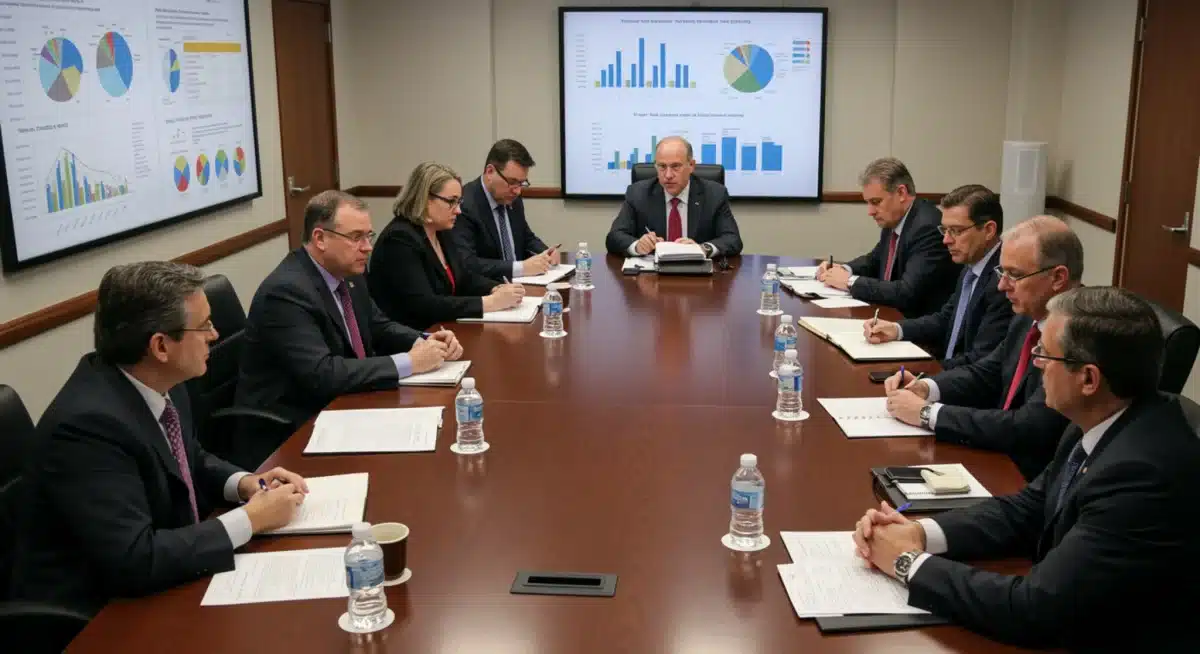
External Influences on Fiscal Debate
- Domestic Public Concern: Fluctuations in public anxiety about debt, influenced by economic conditions and media.
- International Investor Confidence: Global market reactions to U.S. fiscal policies, affecting borrowing costs.
- Global Economic Stability: U.S. debt impacting international trade and financial systems.
- Geopolitical Standing: Fiscal strength influencing diplomatic leverage and global leadership.
Furthermore, the U.S. dollar’s role as the world’s primary reserve currency means that its fiscal health has implications for global financial stability. Major international bodies and economic partners closely monitor U.S. debt levels and fiscal policies. A perceived lack of serious effort to address the debt could erode confidence in the U.S. dollar and potentially trigger broader economic repercussions internationally.
In essence, public opinion and international perception act as critical feedback loops for policymakers. In 2025, a growing sense of urgency from either domestic citizens or global markets could significantly pressure leaders to prioritize debt reduction and adopt more aggressive fiscal reforms, thereby shaping the entire debate.
Long-Term Consequences and Future Generations
The increasing national debt carries profound long-term consequences, particularly for future generations, and this intergenerational burden will be a central theme in the fiscal policy debate of 2025. The decisions made today regarding government spending and taxation will directly impact the economic opportunities and challenges faced by Americans for decades to come, underscoring the need for sustainable and farsighted policy choices.
One of the most significant long-term consequences is the potential for reduced economic mobility and opportunity. As more of the federal budget is consumed by interest payments on the debt, fewer resources are available for investments in education, scientific research, and infrastructure—the very foundations of future economic growth and innovation. This can lead to slower productivity gains and a diminished standard of living for subsequent generations.
Moreover, future generations will inherit a higher tax burden or face cuts to essential government services. If current debt levels are not addressed, future taxpayers will either need to pay more in taxes to service the debt or contend with reduced government support for critical programs like healthcare, social safety nets, and environmental protection. This creates a moral and ethical dilemma for current policymakers: how much debt is acceptable to pass on?
Impacts on Future Generations
- Reduced Investment: Less government funding for education, infrastructure, and R&D.
- Higher Tax Burdens: Future taxpayers may face increased taxes to service inherited debt.
- Service Cuts: Potential reductions in essential government services and social safety nets.
- Economic Instability: Increased vulnerability to economic shocks and crises.
The debate in 2025 will therefore not just be about balancing budgets in the short term, but also about securing a prosperous and stable future. Lawmakers will be pressed to consider the long-term implications of their fiscal choices, weighing immediate political costs against the enduring well-being of the nation. This perspective demands a shift from short-term electoral cycles to a more strategic, generational approach to fiscal management.
In conclusion, the long-term consequences of the national debt for future generations are a critical aspect of the 2025 fiscal policy debate. Addressing this challenge requires a commitment to sustainable policies that safeguard economic opportunity and ensure a robust future for all Americans, transcending immediate political considerations.
Strategies for Sustainable Fiscal Health
Achieving sustainable fiscal health in the face of increasing national debt requires a multi-pronged approach that extends beyond short-term fixes. As the debate over fiscal policy sharpens in 2025, discussions will inevitably turn to comprehensive strategies designed to put the nation on a more responsible financial path. These strategies typically involve a combination of revenue generation, spending control, and economic growth initiatives, all underpinned by a commitment to long-term planning.
One foundational strategy is to implement responsible budgeting practices. This involves setting realistic spending targets, prioritizing expenditures based on national needs, and ensuring that revenue projections are accurate. Moving away from annual crisis-driven budget negotiations towards a more predictable, multi-year budgetary framework could provide greater stability and allow for more strategic planning, reducing the likelihood of last-minute fiscal maneuvers that add to the debt.
Another key strategy involves targeted reforms to entitlement programs. Given that Social Security and Medicare represent significant and growing portions of mandatory spending, any serious attempt to address the national debt must consider their long-term solvency. This could involve gradual adjustments to eligibility ages, benefit formulas, or means-testing, implemented over time to minimize disruption and allow individuals to plan accordingly.
Components of Fiscal Sustainability
- Responsible Budgeting: Multi-year planning, realistic projections, and expenditure prioritization.
- Entitlement Reform: Gradual adjustments to Social Security and Medicare to ensure long-term solvency.
- Tax System Modernization: Reforms to make the tax code more efficient, equitable, and growth-oriented.
- Economic Growth Strategies: Investments in human capital, infrastructure, and innovation to boost GDP.
Furthermore, modernizing the tax system can play a crucial role. This might involve simplifying the tax code, broadening the tax base, or adjusting tax rates to generate sufficient revenue while minimizing disincentives for work and investment. The goal is to create a tax system that is fair, efficient, and capable of funding government operations without hindering economic dynamism.
Finally, fostering robust economic growth is perhaps the most desirable long-term solution. A strong economy naturally generates more tax revenue and makes debt servicing more manageable relative to GDP. Policies that promote education, research and development, and a competitive business environment are essential for achieving this. Combining these strategies—revenue generation, spending control, and economic growth—offers the most promising path towards sustainable fiscal health for the nation.
| Key Point | Brief Description |
|---|---|
| Debt Trajectory | National debt continues to rise due to mandatory spending, healthcare, and interest payments. |
| Economic Impact | Higher interest rates, reduced investment, and potential inflation risks. |
| Policy Debates | Political divides over spending cuts vs. revenue increases will define 2025. |
| Future Burden | Long-term consequences for future generations, including reduced opportunities and higher taxes. |
Frequently Asked Questions About National Debt and Fiscal Policy
The primary driver of the increasing national debt is a combination of mandatory spending on programs like Social Security and Medicare, rising healthcare costs, and the accumulating interest payments on existing debt. These expenditures consistently outpace federal revenues, leading to persistent budget deficits that add to the overall debt.
National debt can affect everyday Americans through higher interest rates on loans, potential inflation, and reduced government investment in public services like infrastructure and education. Ultimately, future generations may face higher taxes or fewer public benefits to service the accumulated debt, impacting economic opportunity.
The main political challenges include deep ideological divides between parties on spending priorities and taxation. Progressive and conservative factions often advocate for sharply contrasting solutions, making bipartisan compromise difficult. Public resistance to entitlement reforms or tax increases further complicates legislative efforts to control the debt.
While robust economic growth can significantly help by increasing tax revenues and making debt servicing more manageable relative to GDP, it is unlikely to solve the national debt problem entirely on its own. Comprehensive solutions usually require a combination of sustained economic growth, responsible spending controls, and targeted revenue enhancements to be effective.
International perception influences the U.S. government’s borrowing costs and its global standing. If international investors perceive the U.S. debt as unsustainable, they might demand higher interest rates for U.S. bonds, increasing the cost of borrowing. This can also affect confidence in the U.S. dollar and impact global financial stability.
Conclusion: Navigating the Fiscal Imperative of 2025
As we look towards 2025, the escalating national debt presents an undeniable and complex challenge that will profoundly shape the debate on fiscal policy. The trajectory of this debt, driven by demographic shifts, healthcare costs, and interest payments, necessitates urgent attention and strategic solutions. The economic implications, from potential interest rate hikes to reduced long-term growth, underscore the gravity of the situation. Political divides will test the capacity for bipartisan cooperation, making the search for feasible solutions a delicate balancing act between revenue enhancements, spending reforms, and robust economic growth strategies. Ultimately, the decisions made in 2025 will not only impact the immediate financial health of the nation but also bear significant long-term consequences for future generations, highlighting the imperative for sustainable and responsible fiscal governance.

